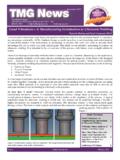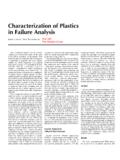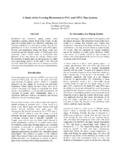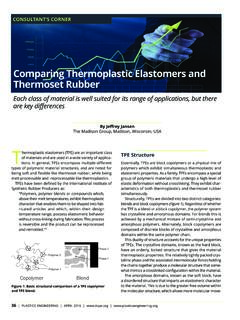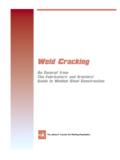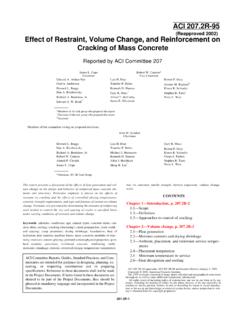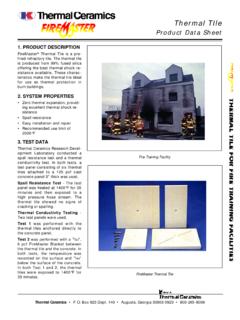Transcription of ENVIRONMENTAL STRESS CRACKING - Madison Group
1 Presented at ANTEC 2005 ENVIRONMENTAL STRESS CRACKING EXAMPLES FROM THE AUTOMOTIVE INDSUTRY Jeffrey A. Jansen, Stork Technimet Abstract Four case studies are presented to illustrate ENVIRONMENTAL STRESS CRACKING (ESC) within automotive components. ESC is a very important mode of plastic component failure. The presented cases illustrate how the failure analysis process was used to identify the failure mechanism as well as the primary factors responsible for the failures. The four cases depict representative automotive failures involving varied designs and service conditions.
2 Background ENVIRONMENTAL STRESS CRACKING (ESC) is widely regarded as the leading cause of plastic product failure. A recent study indicated that approximately 25% of plastic component failures are associated with ESC1. ESC is a failure mechanism whereby a plastic resin is effected by a chemical agent while simultaneously under tensile loading. It is a solvent-induced failure mode brought about by the synergistic effects of the chemical agent and the mechanical STRESS .
3 As part of ESC, there is no chemical attack or molecular degradation. Conversely, the chemical permeates into the molecular structure and interferes with the intermolecular forces binding the polymer chains, causing molecular ESC is a brittle fracture mode and the steps involved in the mechanism include fluid absorption, plasticization, craze initiation, crack growth, and finally fracture. Recent comparisons have illustrated similarities between ESC and creep, sometimes referred to as static Creep is the application of static stresses, below the yield point, over an extended period of time.
4 The presence of the ESC agent simply reduces the time to failure, or alternatively, reduces the level of STRESS required to initiate the failure. Experimental Surfaces of the exemplar failed components were examined using a Hitachi S-3500N scanning electron microscope (SEM). The specimens were blown off and cleaned ultrasonically in a mixture of isopropanol and deionized water. Prior to the inspection, the surfaces were gold sputter coated to enhance the imaging. Samples representing the materials were analyzed using micro-Fourier transform infrared spectroscopy (FTIR) in the attenuated total reflectance (ATR) mode.
5 A Nicolet Magna 550 spectrometer interfaced with a Nic-Plan IR microscope was used for the analysis. Sample materials from failed components were analyzed using thermogravimetric analysis (TGA). The testing was performed on a TA Instruments 2950 TGA. The thermal program involved dynamic heating at 20 C/min. using sequential nitrogen and air purge atmospheres. Material samples were evaluated using differential scanning calorimetry (DSC). The testing was conducted using a TA Instruments 2010 DSC.
6 The analysis involved heating the samples at 10 C/min. through the transition. Thermomechanical analysis (TMA) was used to evaluate materials from the failed parts. The testing was performed on a TA Instruments 2940 TMA. A heating rate of 5 C/min. was utilized in conjunction with a N loaded expansion probe. The molecular weights of the failed part materials were evaluated indirectly by melt flow rate. Tests were conducted in accordance with ASTM D 1238 using an appropriate test temperature and constant load.
7 Tests and Results Mirror Housing Failure A set of prototype external mirror housings had failed during a thermal/vibration engineering evaluation. The testing included exposing the assembled parts to extremes in temperature while under vibrational testing. The plastic mirror housings were secured to the mating steel rod with a coated steel clamp. The housings had been molded from a poly(acrylonitrile:butadiene:styrene) (ABS) resin , and this represented a change from the previous polypropylene resin.
8 The visual examination of the mirror housings confirmed the presence of a substantial level of CRACKING immediately surrounding the fastening hole. The CRACKING was most heavily concentrated within the area that had been in contact with the clamp that secures the housing to the pole. A microscopic inspection of the opened fracture surfaces revealed features indicative of crack initiation along the exterior surface of the housings, as shown in Figure 1. Additionally, an oily residue was found covering the fracture surfaces.
9 At slightly higher magnifications, radiating features, suggestive of a progressive failure mode were evident. These features covered approximately 80% of the fracture surface extending from the exterior wall, with the remaining 20% closest to the interior wall showing features indicative of tensile overload, associated with the final fracture zone. Now with The Madison Group Presented at ANTEC 2005 Representative fracture surfaces were examined via SEM, and the observed features confirmed that multiple individual cracks had initiated along the exterior edge of the mirror housing wall.
10 The morphology within the crack origin zone was relatively, smooth, indicating slow crack initiation. Outside of the origin zone, the fracture surface exhibited signs of moderate micro ductility in the form of stretched flaps. Additionally, the surface outside of the crack origin area displayed a series of radiating features. At high magnification these features were present as bands of opened craze remnants. The fracture surface along the interior housing wall, remote to the area of crack initiation, showed contrasting features.

